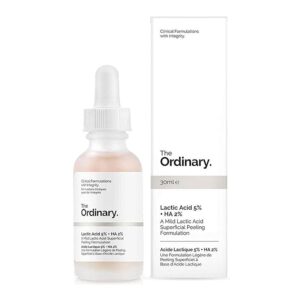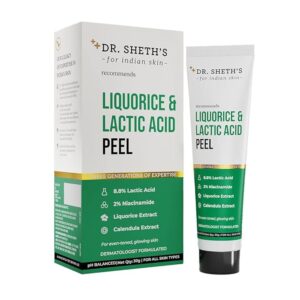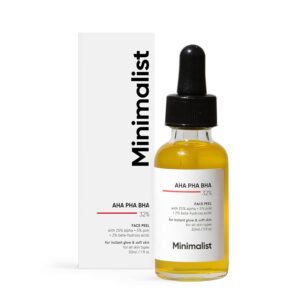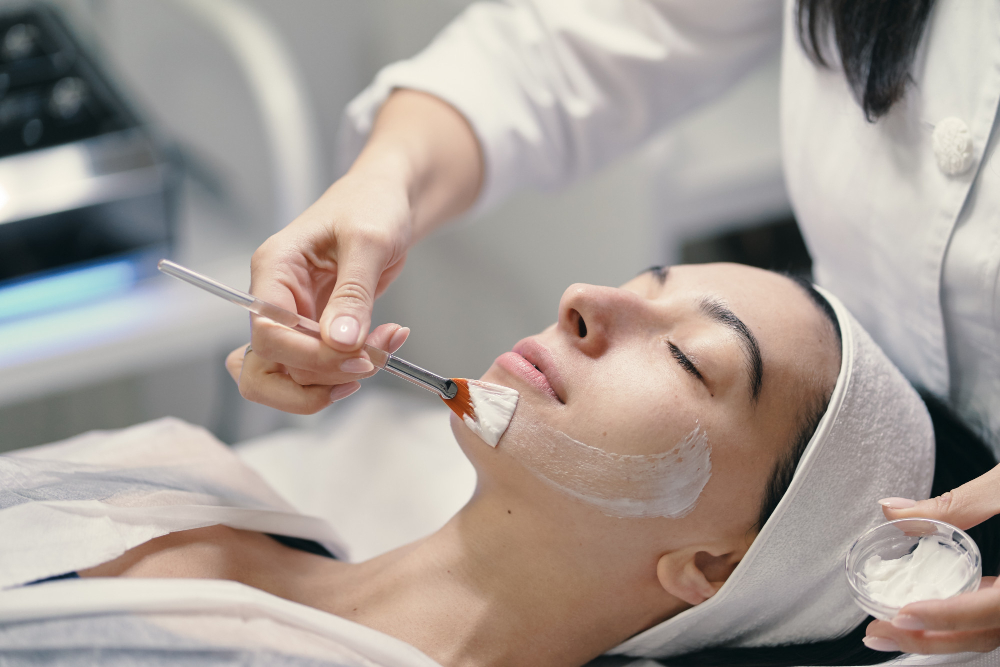/IN THIS ARTICLE
♥ What is a Lactic Acid Peel?
♥ The Amazing Benefits of a Lactic Acid Peel: What You Need to Know
♥ How Lactic Acid Peels Work
♥ Best Lactic acid peels
♥ Lactic Acid Peel: Your Guide to Gentle and Radiant Skin
♥ How Is a Lactic Acid Peel Applied?
♥ What Does It Cost in India?
♥ Are There Any Side Effects?
♥ Lactic Acid Peel vs. Glycolic Acid Peel
♥ What to Expect After a Lactic Acid Peel
♥ Before & After: The Transformation
♥ Final Thoughts: Is a Lactic Acid Peel Right for You?
♥ FAQ
What is a Lactic Acid Peel?
When it involves skincare, a Lactic Acid Peel stands proud as one of the gentlest approaches to provide your pores and skin a refreshing raise. So, what exactly is it? Well, it’s a kind of chemical exfoliation that uses lactic acid—an alpha hydroxy acid (AHA) that comes from milk. If you’ve been given touchy pores and skin or you’re new to peels, this might simply be the proper solution for you.
The Amazing Benefits of a Lactic Acid Peel: What You Need to Know
Lactic acid peels are gaining a reputation and for an awesome reason. If you’re looking to refresh your pores and skin and achieve a radiant complexion, this treatment is probably your mystery weapon.
1. Reducing Wrinkles and Fine Lines
2. Getting Rejuvenated, Younger Skin
3. Less downtime, more outcomes
4. The exfoliation procedure for dead skin cells
5. Addressing Acne and Its Aftereffects
How Lactic Acid Peels Work
Lactic acid peels comprise concentrations of the acid that commonly vary from 30% to 70%. The percentage used depends on numerous factors: how sensitive your skin is, how much damage you’re seeking to deal with, and of course, the results you’re aiming for. The beauty of these peels lies in their flexibility.
A lactic acid peel is a type of chemical peel that makes use of lactic acid, an alpha hydroxy acid (AHA) derived from milk, to exfoliate the pores and skin. It is a popular treatment for improving pores and skin texture, tone, and normal look.
Best Lactic acid peels:-
1.Pilgrim 25% AHA + 2% BHA + 5% PHA Peeling Solution.
Pros:-
Unisex Use: Suitable for both women and men, making it versatile and handy for numerous skin sorts and genders.
Cons:-
Limited Frequency of Use: The product is powerful and ought to best be used a few times every week, so it’s no longer perfect for those looking for daily exfoliation solutions.
Product asset – lactic acid, glycolic acid, salicylic acid, and hyaluronic acid
Skin Type – All
Item style – Drop
Shop Now : AT AMAZON

2.The Ordinary Lactic Acid 5% + Ha 2% 30ml.
Pros:-
Improves Skin Texture: Regular use allows for smoothing out difficult patches and selling an even, radiant complexion by way of doing away with lifeless pores and skin cells from the floor.
Cons:-
Need for Consistent Use: To see seen outcomes, the product should be used constantly over a duration of weeks, and some customers can also discover this endurance-trying out.
API – Lactic acid
Product asset – Exfoliating
Skin Type – Normal
Shop Now : AMAZON

3.Dr. Sheth’s Liquorice & 8.8% Lactic Acid (AHA) Chemical Peel.
Pros:-
Evens Skin Tone: Liquorice extract is understood for its brightening houses, assisting to reduce pigmentation and dark spots for a extra even-toned complexion.
Cons:-
Requires Sunscreen: Like all AHA-primarily based exfoliants, it makes the skin extra touchy to the sun, so diligent use of sunscreen is important to avoid solar damage.
API – Hyaluronic acid, lactic acid, and niacinamide
Skin Type – All
Item style -Lotion
Shop Now : AMAZON

4.AHA BHA PHA Peel For Weekend Exfoliation.
Pros:-
Brightens the Skin: The aggregate of acids enables in lowering of dullness, main to a more radiant and glowing complexion.
Cons:- Not Suitable for Beginners.
API – Salicylic Acid, Glycolic Acid
Skin Type – All, Dry, Normal, Sensitive, Oily
Item style -Serum
Shop Now : AMAZON

Lactic Acid Peel: Your Guide to Gentle and Radiant Skin
When it comes to skincare, there’s a buzzword floating around that has splendor fanatics and dermatologists alike speak to me—lactic acid peel. If you’re questioning what the hype is set, stick around. Let’s dive into why this gentle yet powerful remedy is turning into a cross-to solution for glowing, healthier pores and skin.
What Exactly Is a Lactic Acid Peel?
Think of lactic acid peels as the skincare world’s closing multitaskers. Derived from milk (yes, milk!), this Alpha Hydroxy Acid (AHA) peel is celebrated for its mildness and effectiveness. Its mild nature makes it a high-quality desire for touchy skin at the same time as handing over a range of pores and skin advantages.
The concentration of lactic acid in those peels typically stages between 30% and 70%, custom-designed to suit your skin’s desires:
- Low Concentration (30-forty%): Ideal for first-timers or people with oily, zits-inclined skin.
- Mid-Range Concentration (40-60%): Perfect for ordinary to dry skin, imparting a hydrating raise.
- High Concentration (60-70%): Suited for mature skin, targeting excellent lines and dullness.
How Is a Lactic Acid Peel Applied?
Applying a lactic acid peel isn’t rocket science, however, it’s excellent left to an expert to ensure secure and powerful outcomes. Here’s what the system generally looks as if:
- Cleanse: Your face is thoroughly wiped clean to dispose of any dust or makeup.
- Protect Sensitive Areas: Petroleum jelly or Vaseline is applied around touchy spots just like the corners of your eyes, nose, and mouth.
- Eye Protection: Cotton pads are used to protect your eyes.
- Application: A brush applicator spreads the lactic acid answer evenly throughout your face.
- Wait Time: The answer sits for your skin for about five–10 mins, depending on its attention and your skin’s sensitivity.
- Neutralize: A neutralizing solution is carried out to prevent the peel, accompanied by the aid of a thorough wipe-off.
- Aftercare: A bloodless compress is implemented to calm the skin, accompanied by the aid of a calming cream and sunscreen.
What Does It Cost in India?
Lactic acid peels are especially finance-friendly, especially thinking about the benefits they provide. In India, an unmarried session can value everywhere from ₹1,500 to ₹3,500, depending on factors like:
- The sanatorium or salon you choose.
- The attention of lactic acid used.
- The number of periods wanted to your preferred outcomes.
Benefits That Will Make You Love Lactic Acid Peels
Don’t underestimate this mild peel—it’s filled with effective blessings:
- Balances pH Levels: Helps keep your pores and skin’s best pH for a healthful complexion.
- Exfoliation at Its Best: Removes dead skin cells, unclogs pores, and complements the absorption of your skincare merchandise.
- Anti-aging Perks: Stimulates collagen and elastin production, reducing great traces and wrinkles.
- Brightens Skin: Reduces dark spots and hyperpigmentation, giving you extra even pores and skin tone.
- Hydrates and Soothes: Moisturizes dry skin even as additionally controlling excess oil in pimples-susceptible areas.
Are There Any Side Effects?
Thanks to its mild system, lactic acid peels come with minimum facet effects. However, it’s continually excellent to recognize what to expect:
- Sun Sensitivity: Your skin will need greater protection from UV rays—hey, sunscreen!
- Temporary Redness: Mild redness or warmth may appear but commonly subsides within a few hours.
- Peeling: With better concentrations, anticipate a few pores and skin peeling for an afternoon or two.
Lactic Acid Peel vs. Glycolic Acid Peel
You’ve probably heard approximately glycolic acid peels too. So, how are those examined? Both belong to the AHA’s own family, but here’s the important thing difference:
- Source: Lactic acid comes from fermented milk, whilst glycolic acid is derived from sugarcane.
- Intensity: Glycolic acid penetrates deeper into the skin, making it stronger but potentially harsher.
- Best For: Lactic acid is super for sensitive pores and skin or novices, at the same time as glycolic acid fits those looking for an extra excessive peel.
What to Expect After a Lactic Acid Peel
Post-peel, your pores and skin will feel tender, hydrated, and rejuvenated. While the deep moisturizing effect is immediate, improvements in tone and texture become important in the following days. For the most appropriate outcomes, everyday sessions spaced out over a few weeks are encouraged.
Pro Tip: Don’t skimp on solar protection! Your skin might be greater sensitive to UV rays, so follow sunscreen diligently and remember to carry wide-brimmed hats whilst stepping outdoors.
Before & After: The Transformation
A lactic acid peel doesn’t carry out miracles in a single day, but its cumulative effect is marvelous. Expect smoother, brighter skin, with fewer dark spots and exceptional strains over the years. Its gentle nature way fewer risks, making it a safe guess for most skin sorts.
Final Thoughts: Is a Lactic Acid Peel Right for You?
If you’re searching for a skin remedy that’s mild but effective, a lactic acid peel would possibly simply be your new high-quality pal. Start with a lower awareness to see how your skin responds and work your manner up as needed. Whether you are battling zits, dryness, or dullness, this peel gives a bit of something for everyone—without the harsh side results.
FAQ:-
1. Is a lactic acid peel appropriate for sensitive pores and skin types?
- Yes, it’s regularly advocated for touchy skin because of its moderate nature, specifically at lower concentrations.
- Always do a patch take a look at first to make sure compatibility and avoid inflammation.
2. How long does it take to look at results from a lactic acid peel?
- You may also observe smoother, brighter skin after an unmarried use.
- Consistent use over weeks will yield improvements in texture, tone, and first-rate traces.
3. Should I keep away from daylight after using a lactic acid peel?
- Yes, the skin will become extra touchy to sunlight after a peel.
- Use sunscreen diligently and avoid extended solar publicity for at least 48 hours.
Related article: Lactic Acid Skin care: Benefits & How It Works for Glowing Skin



Leave a Reply